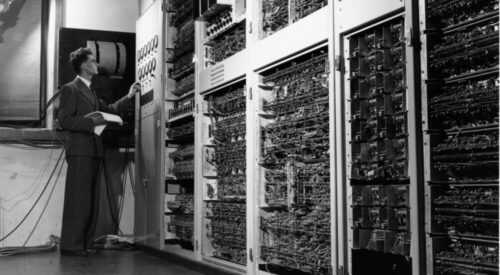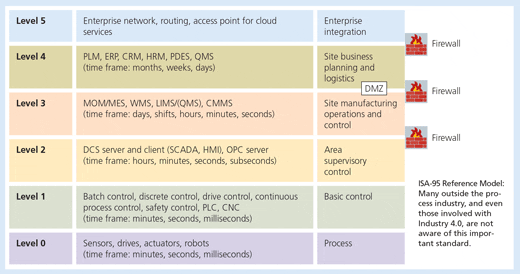In some ways, the Second Industrial Revolution finished what the First started. Powering machines with steam had been a massive step forward, but by the 1840s/50s the pace of innovation had slowed. It wasn’t until the 1870s, when electricity was made broadly available and was combined with increased labor, natural resources and a network of railroads that the Second Industrial Revolution took off, triggering a degree of change without historical precedent.
Fast forward to 2020, it now feels as if history is repeating itself.
The Second Industrial Revolution took us through the ~1970s, when the emergence of digital electronics ushered in The Digital Revolution (a.k.a. the Third Industrial Revolution). Built on a foundation of transistors, integrated circuits and semiconductors, this period was ultimately defined by the computers and software it enabled. Analog shifted to digital. The ERP was born.
And, unwittingly, a degree of control shifted from manufacturing operators to IT.
Few disputed the meaningful advances delivered by software. But it was also clear to some that, while a large step forward had been taken, a meaningful gap had emerged between manufacturing operations and the technology systems running them.
Similar to how electricity, an expanded labor pool and railroads transformed steam powered machines, an additional set of “unlocking” advances were needed to maximize value from software in a manufacturing context.
Such an opening began to take shape in 2013 when a working group jointly led by Henning Kagermann, ex-CEO of ERP giant SAP, presented a report titled “Industrie 4.0” to the Hannover Fair. In it, they laid out an initial vision for a manufacturing system with the ability to self-optimize. These principles, which have evolved greatly the past seven years to now encompass the tenets of the Fourth Industrial Revolution, represent an era defined by the fusion of data, machines and people.
As this post will explore, Industry 4.0 has now matured to a point of meaningful value creation among manufacturers, transforming the way work is done and reshaping people’s perceptions of what is possible.
The Limits of Industry 3.0
There’s an old joke in the IT world, “What’s the average length of an ERP implementation?” The answer, “Two CIOs”.
Few activities are more challenging or more expensive than implementing a sophisticated software application in a manufacturing setting. To allow software companies to sell the same applications to thousands of customers, there is a massive amount of configuration and customization required. And because activities are connected to upstream and downstream operations, an incredible amount of testing is required to ensure a smooth go-live.
Despite these painful implementations, the efficiencies generated by connecting organizational silos are compelling enough that most organizations have taken the plunge.
To complete the vision of a fully connected manufacturing operation, Industry 3.0 produced frameworks such as ISA-95 (see image below), which articulates a system architecture at various levels and remains highly relevant today:
Source: https://www.isa.org/intech/20181202/
Progressive organizations following these tenets achieved meaningful advances in areas such as automation, dashboard visibility and supply chain optimization. But over time, several meaningful shortcomings persisted in Industry 3.0 environments:
- Poured in concrete: changes have proven difficult and require the active involvement of IT, a group that is often meaningfully removed from business realities. This inhibits the type of rapid, incremental enhancements that create business value
- Edge data sources (e.g. IoT) not easy to fully leverage: the past decade has experienced an explosion of data sources, including the rapid scale of IoT sensors. It is now possible to equip all workstations and manufacturing equipment with hardware sensors, but many of the legacy applications installed in the past were not designed to analyze or optimally action this information
- Poor leverage of both big data and the human operator: in many ways, legacy manufacturing software viewed workers as entities to control, not to empower. Instructions were provided and simple feedback collected, but environments failed to provide rich, interactive dashboards powered by big data enabling line workers to derive insights and take actions to improve operations
The Promise of Industry 4.0
When Industry 4.0 initially debuted, there was much talk of increased automation enabling “lights out” manufacturing, a narrative that understandably triggered a backlash driven by worries of worker disenfranchisement.
Fortunately, as the movement has matured, “lighthouse” companies – manufacturers who have effectively embraced the principles of Industry 4.0 – have charted a different course. Instead of marginalizing workers, the ecosystems that have emerged place the human at the center.
This is, in fact, the salient principle of Industry 4.0 — the idea that combination of new data sources (e.g. IoT) + improved data analysis tools + interactive tablets placed in workers’ hands can unlock powerful new ways to operate. And that when organizations reorient their cultures around the identification and exploitation of these opportunities, they can create enduring value.
How to Start
As referenced in The World Economic Forum’s comprehensive white paper on the Fourth Industrial Revolution, roughly 70% of industrial companies attempting to deploy Industry 4.0 principles have gotten stuck in “pilot purgatory”.
A key reason for this is the fact that, although Industry 4.0 certainly leverages meaningful advances in technology, it has massive cultural and change components as well. And shifting culture requires multi-level buy-in paired with dogged perseverance.
Like most transformation efforts, the act of overcoming initial inertia benefits greatly from early success. To achieve quick wins, firms should begin by looking at their core processes and identifying pain points and opportunities easily addressable by Industry 4.0 principles. From there, a set of enabling tactics and technologies can be prescribed to enable the quick wins that provide kindling for a growing transformation.
For many companies, a good place to start involves making data visible and actionable that was previously “trapped” by paper-based processes or siloed business applications. By consolidating this data and making it viewable in contextually relevant dashboards, companies can find simple ways to empower shop floor workers to improve a small component of the operation. In addition to taking a first step toward making change agents within the organization, digitizing and/or consolidating data also lays the foundation for future big data projects to derive more sophisticated insights via techniques like AI / ML.
Too often, companies take the opposite approach: they start by choosing a set of buzz-worthy technologies (e.g. IIOT, AR/VR, AI / ML, Cloud) and find use cases during their implementation. A proverbial hammer looking for a nail, this often leads to the suboptimal use cases, a dynamic that undermines the credibility of the project.
How to Scale
To achieve meaningful results, an ongoing commitment to change is required. As mentioned previously, this is as much about managing culture as it is about leveraging technology.
Principles to embrace include:
- Prioritize data management: there are few catalysts for innovation more impactful than having clean, organized, accessible data. It is the prerequisite to many valuable use cases and is something many organizations fail to take as seriously as they should
- Place operators at the center: Industry 4.0 produces the greatest benefits – both culturally as well as financially – when it focuses on augmenting, not replacing, workers. An interesting question to ponder of various operator roles is, “What would this individual do differently if they had access to all information in real-time?”
- Leverage agile principles: although agile has sometimes been used to justify environments without structure, when done intentionally, it produces a steady stream of functional advances. Embracing an active agile working mode will, over time, build vital capabilities within organizations enabling rapid, cost-effective value creation
- Supplement with specific skillsets: there are many skills that are best rented. But there are some, such as technology practitioners with the ability to integrate systems and connect IoT devices with data lakes and/or end-user apps, that can meaningfully increase velocity
- Make all locations part of the solution: it is common for organizations to concentrate skills in specific places. Resisting the natural tendency to do so, instead opting to spread competencies geographically throughout your organization. This will go a long way towards making each node a contributing part of ongoing value creation
Technologies to Leverage Along the Way
Most organizations enter their Industry 4.0 journeys with a host of legacy technologies. And fortunately, in most situations the foundational components of an organization’s technology footprint can be leveraged.
With this said, some areas where supplemental technology can play a key role include:
- IoT sensors: An obvious prerequisite to running a connected factory is connecting all relevant machines and workstations. For endpoints not pre-equipped with sensors, organizations can choose install IoT sensors, connect them to a centralized data gateway and make them accessible to the broader system. In addition to the global leaders of IoT sensors (e.g. Texas Instruments), a rich collection of mid-sized players has emerged, including Particle (“sensors for IoT app developers”), mCube (tiny wearable sensors), and PTC (enterprise-grade sensors for OEMs)
- “Digital manufacturing platform”: From our perspective, the key technology decision related to Industry 4.0 represents the (likely cloud-based) platform through which interaction with operators will take place. Important characteristics of this technology include the ability to easily develop new use cases, ideally without much IT involvement, as well as the ability to render strong graphics. Two players with strong offerings in this space are Tulip and Red Zone, which we wrote about in a recent blog post.BI platforms that support horizontal and vertical data exploration, such as Sisense, could also be leveraged, as could more basic, lower-cost BI tools such as PowerBI (Microsoft) and QuickSight (Amazon). Platform-specific offerings such as Movilitas, which pairs natively with SAP, can also be a great option
- AI / ML: getting the shop floor “fully wired” and equipped with a digital manufacturing platform enables dozens of use cases in the areas of machine monitoring, quality control, training, document management, etc. To enable more sophisticated use cases, manufacturing-specific AI packages such as C3 AI or Element AI can be a powerful option. Alternatively, firms can develop custom programs by leveraging lower-level AI engines from tech royalty (e.g. Google, Microsoft, Facebook, Amazon).There are also vendors such as Falkonry that provide vertically integrated solutions (Oil & Gas, Mining & Metals, Defense & Intelligence, Semiconductor, Automotive, Chemical) encompassing IoT sensors, a digital manufacturing platform and AI / ML driven insights
Building enduring advantage in business has never been the product of silver bullets, and none of the Industry 4.0 technologies or operational shifts will transform companies overnight. But by placing an ongoing importance on incremental gains driven on the premise of connecting data, machines and people, manufacturers can move the needle on the KPIs that drive their business. And they can do so while concurrently benefitting their workers, the environment, and their company financials.






